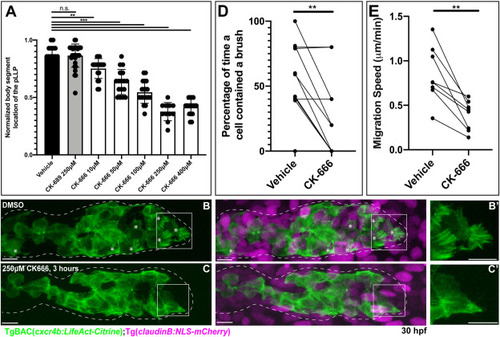Fig. 2
- ID
- ZDB-FIG-210204-24
- Publication
- Olson et al., 2020 - Lamellipodia-like protrusions and focal adhesions contribute to collective cell migration in zebrafish
- Other Figures
- All Figure Page
- Back to All Figure Page
|
Fig. 2. Arp2/3 activity is required for brush-like protrusion formation and pLLP migration. (A) Effects of increasing concentration of CK-666 on pLLP migration in comparison to vehicle and inactive control drug, CK-689. (B) Mosaically labeled embryos carrying TgBAC(cxcr4b:LifeAct-Citrine) transgene were first exposed to DMSO (vehicle) and imaged for 1.5 h beginning at 30 hpf (Movie 2). (C) Following DMSO treatment, embryos were then exposed to the Arp2/3 inhibitor CK-666 for 4 h and concurrently imaged (Movie 2). Note the loss of brush-like protrusions following the treatment. Images show lateral views. (B′,C′) 1.8X zoom of boxed cells in B and C. (D) Percentage of time a given cell contained a brush-like protrusion during vehicle and the inhibitor treatment (n = 11 cells from 6 embryos). (E) Migration speed of the whole pLLP during vehicle and inhibitor treatment (n = 8 whole pLLPs). Asterisks = brush-like protrusions. Scale bar = 10 μm. |
Reprinted from Developmental Biology, 469, Olson, H.M., Nechiporuk, A.V., Lamellipodia-like protrusions and focal adhesions contribute to collective cell migration in zebrafish, 125-134, Copyright (2020) with permission from Elsevier. Full text @ Dev. Biol.

